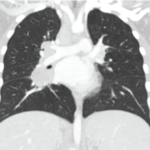REF Investigators’ Meeting brings researchers together to search for RA cure
The ACR/CHEST ILD Guidelines in Practice, a video
In collaboration with the American College of Chest Physicians, the ACR released two new comprehensive guidelines aimed at improving the screening, monitoring, and treatment of patients with interstitial lung disease (ILD) secondary to systemic autoimmune rheumatic diseases (SARDs). Recently, Sindhu R. Johnson, MD, PhD, professor of medicine at the University of Toronto, Canada, director of the Toronto Scleroderma Program and principal investigator for the guideline, and Elana J. Bernstein, MD, MSc, Florence Irving associate professor of medicine in the Division of Rheumatology at Columbia University, New York City, and co-first author, presented a webinar to talk about how the guidelines were developed and present some of the recommendations and their rationale: Watch the recording now!
Aggressive Urate Lowering Needed for Gout
Patients with gout at increased risk for cardiovascular disease and adverse event
The Basic Science of the Annual Scientific Meeting
The ACR/ARHP Annual Scientific Meeting is the premier event for specialists in the field of rheumatology. At this year’s meeting, basic researchers will have multiple opportunities to increase their knowledge, and there will be something for every interest.
Within Our Reach: Collaborating to Find a Cure for RA
Research is critically important to find cures and accelerate patient care for the millions who suffer from arthritis and rheumatic disease. Despite its prevalence in the population and recent treatment advances, rheumatoid arthritis (RA) remains an incurable disease and receives disproportionately less research funding from federal sources than most other autoimmune diseases. This is precisely why the ACR Research and Education Foundation (REF) launched Within Our Reach: Finding a Cure for Rheumatoid Arthritis to directly invest in the types of innovative research not being done elsewhere in the country.
Advocating for Arthritis: My First Time on the Hill
Amidst the most momentous week of the year’s tumultuous healthcare reform activities, we arrived in Washington, D.C., for the annual ACR Advocates for Arthritis Capitol Hill Fly-In. This was to be my first visit to Congress. Although my alma mater, Georgetown University, was a short distance from the Capitol dome, as a student I had little interest in the political process—particularly as it related to medicine. Now, however, as a young rheumatologist, I am increasingly aware of the impact health policy has on my daily practice. I have also watched the healthcare reform debate unfold over the last year, recognizing that this is a critical time for physicians to be vocal and active. There is a great deal at stake, and we are surrounded daily by the very issues debated in Washington. Why not take our opinions directly to the decision makers?
Industry Support & Quality Initiatives
How the ACR manages conflict-of-interest policies
Ethics Forum: Understanding the Challenges in Rheumatology Today
Understand the challenges in rheumatology today
Tracking Patient Manifestations of Behçet’s Syndrome around the World
Tracking patient manifestations of Behçet’s syndrome around the world
New Musculoskeletal Ultrasound Course
The ACR is broadening its educational offerings in musculoskeletal ultrasound by holding its first stand-alone musculoskeletal ultrasound course for rheumatologists this August in Chicago. The same course will be offered prior to the 2010 ACR/ARHP Annual Scientific Meeting.
New Workshops on Patient Findings and Joint Injections
There is a critical shortage of rheumatologists in the U.S. The aging of the U.S. population, along with recent changes in healthcare reform, makes it critical for rheumatology practices across the U.S. to plan for the maintenance of accessible, high-quality care for patients. Establishing a collaborative rheumatology practice between a rheumatologist and a nurse practitioner or physician assistant (NP/PA) has been identified as one solution, but there are few rheumatology specialty training opportunities for NPs and PAs. The ARHP has identified the need to provide training for this portion of its membership and is now expanding its offerings for NPs and PAs through four new workshops at the annual meeting in November.
- « Previous Page
- 1
- …
- 279
- 280
- 281
- 282
- 283
- …
- 309
- Next Page »
